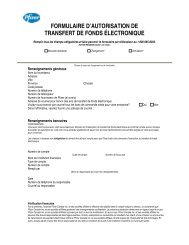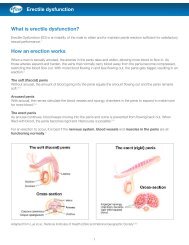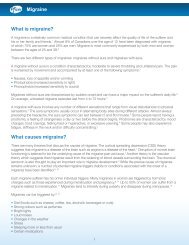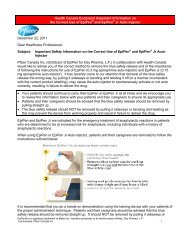Medication Safety for Children: A Guide for Parents and ... - Pfizer.ca
Medication Safety for Children: A Guide for Parents and ... - Pfizer.ca
Medication Safety for Children: A Guide for Parents and ... - Pfizer.ca
Create successful ePaper yourself
Turn your PDF publications into a flip-book with our unique Google optimized e-Paper software.
<strong>Medi<strong>ca</strong>tion</strong> <strong>Safety</strong> <strong>for</strong> <strong>Children</strong>: A <strong>Guide</strong> <strong>for</strong> <strong>Parents</strong> <strong>and</strong> Caregivers<br />
When it comes to medicine, children are not just “little adults.” If you take <strong>ca</strong>re of a child, know these<br />
special safety considerations <strong>for</strong> both prescription <strong>and</strong> nonprescription medi<strong>ca</strong>tions.<br />
Prescription medicines: Get the facts<br />
Never give a child a prescription medi<strong>ca</strong>tion intended <strong>for</strong> an adult or another child.<br />
If a medicine is prescribed <strong>for</strong> your child by a physician or another member of the family’s health <strong>ca</strong>re<br />
team, two important ways to reduce the risk of any safety problems with the medicine are: Tell the<br />
prescriber about your child’s health <strong>and</strong> other medi<strong>ca</strong>tions taken, <strong>and</strong> ask about the medi<strong>ca</strong>tion<br />
being prescribed.<br />
Tell the doctor:<br />
• Your child’s medi<strong>ca</strong>l history.<br />
• Any allergies or sensitivities he or she has experienced.<br />
• Any concerns that would affect your child’s ability to take medicine, such as difficulty<br />
swallowing tablets.<br />
• Any other prescription or nonprescription medi<strong>ca</strong>tions, vitamins or supplements, herbal or<br />
other natural or alternative remedies your child is taking.<br />
Ask the doctor:<br />
• What is the medicine <strong>and</strong> what is it <strong>for</strong>?<br />
• Could this medicine interact with any other prescription or nonprescription medi<strong>ca</strong>tions my<br />
child is taking?<br />
• How often should my child take this medicine? For how many days or weeks?<br />
• What if I miss giving my child a dose?<br />
• How soon will the medicine start to work?<br />
• What side effects might occur?<br />
• What should I do if my child seems to develop any of these side effects?<br />
• Should I stop giving the medicine when my child gets better?<br />
• Can the medicine affect my child’s per<strong>for</strong>mance at school?<br />
• Can the medicine have any long-term effects on my child’s growth <strong>and</strong> development?<br />
At the pharmacy:<br />
• Check that the medicine looks like what you expected from the doctor's description, <strong>and</strong> that<br />
the label matches what the doctor prescribed. If not, ask the pharmacist about it.<br />
• Read any printed in<strong>for</strong>mation that comes with the medicine. If you have any questions, ask<br />
the pharmacist or your doctor.<br />
© 2008 <strong>Pfizer</strong> Inc. All rights reserved. Version 1.0. August 2008.<br />
For more in<strong>for</strong>mation on medicine safety, please visit: www.pfizer.com/medicinesafety 1
<strong>Medi<strong>ca</strong>tion</strong> <strong>Safety</strong> <strong>for</strong> <strong>Children</strong>: A <strong>Guide</strong> <strong>for</strong> <strong>Parents</strong> <strong>and</strong> Caregivers (cont’d)<br />
Keeping track of dosage<br />
<strong>Children</strong>’s small bodies are vulnerable to the risk of<br />
accidental overdose. That’s why accurate dosing <strong>and</strong><br />
If your child will need to have a<br />
measurement of children’s medi<strong>ca</strong>tions, especially<br />
medicine administered in school or<br />
day <strong>ca</strong>re…<br />
liquids, is so important. When your child takes any<br />
Learn how the procedure is h<strong>and</strong>led<br />
medi<strong>ca</strong>tion, start a simple record (like a chart or<br />
there, <strong>and</strong> make sure the safeguards<br />
checklist) of each dose given <strong>and</strong> when. Don't rely on<br />
listed on this sheet are in place.<br />
young children to tell you whether they have taken their<br />
medicine—they may say “yes” be<strong>ca</strong>use they don’t like it,<br />
or even “no” to get a second dose if they liked the flavoring. Watch them take the entire dose.<br />
Measurements count!<br />
Age is not always an accurate measure of how much medicine to give your child. Check the “Drug<br />
Facts” label of nonprescription medicines <strong>and</strong>, if the in<strong>for</strong>mation is available, use your child’s weight<br />
to find the right dose. Don’t guess. If you are not sure or do not underst<strong>and</strong> the label instructions, ask<br />
your doctor or pharmacist.<br />
Use the measuring tool that comes with your child’s medicine. If a product doesn’t come with a<br />
special measuring tool, ask <strong>for</strong> one at the pharmacy; a household spoon may not hold a precisely<br />
accurate amount of medicine. The numbers on measuring devices are small, so read them <strong>ca</strong>refully.<br />
Here are some tips <strong>for</strong> accurate measuring:<br />
Dosage cups are <strong>for</strong> children who <strong>ca</strong>n drink from a cup without spilling. Look<br />
closely at the numbers on the side; measure out the liquid with the cup at eye level<br />
on a flat surface.<br />
Cylindri<strong>ca</strong>l dosing spoons are <strong>for</strong> children who <strong>ca</strong>n drink from a cup but are still<br />
prone to spill. These devices look like a wide straw with a little spoon at the top.<br />
Measure the liquid in the spoon at eye level, <strong>and</strong> have the child sip the medicine<br />
from the spoon.<br />
Droppers are <strong>for</strong> children who <strong>ca</strong>n't drink from a cup. Put the medicine into the<br />
dropper <strong>and</strong> measure at eye level; give to the child quickly be<strong>for</strong>e the medicine<br />
drips out.<br />
Syringes are another option <strong>for</strong> children who <strong>ca</strong>n't drink from a cup, allowing you<br />
to squirt the medicine into the back of the child's mouth. If a syringe comes with a<br />
<strong>ca</strong>p to keep medicine from leaking out, remove <strong>and</strong> dis<strong>ca</strong>rd the <strong>ca</strong>p (a choking<br />
hazard) be<strong>for</strong>e giving the medicine. For some medicines, a syringe may be filled<br />
with the right dose <strong>and</strong> left, <strong>ca</strong>pped, <strong>for</strong> a <strong>ca</strong>regiver to give to your child later. (Tell<br />
the <strong>ca</strong>regiver to remove the <strong>ca</strong>p first <strong>and</strong> dis<strong>ca</strong>rd it.) Use only clean syringes<br />
specially made <strong>for</strong> giving medicines to children. Be sure to store the filled syringe at<br />
the right temperature <strong>and</strong> never leave it where children or pets may get it.<br />
© 2008 <strong>Pfizer</strong> Inc. All rights reserved. Version 1.0. August 2008.<br />
For more in<strong>for</strong>mation on medicine safety, please visit: www.pfizer.com/medicinesafety 2
<strong>Medi<strong>ca</strong>tion</strong> <strong>Safety</strong> <strong>for</strong> <strong>Children</strong>: A <strong>Guide</strong> <strong>for</strong> <strong>Parents</strong> <strong>and</strong> Caregivers (cont’d)<br />
Special <strong>ca</strong>utions <strong>for</strong> nonprescription medicines<br />
Medicines purchased without a prescription (<strong>ca</strong>lled “over-the-counter,” or nonprescription,<br />
medicines) often contain the same ingredients as prescription medicines <strong>and</strong> <strong>ca</strong>n pose serious safety<br />
risks. Give infants <strong>and</strong> children only medi<strong>ca</strong>tions specifi<strong>ca</strong>lly <strong>for</strong>mulated <strong>for</strong> their age <strong>and</strong> weight.<br />
Don’t cut adult tablets in half or estimate a child’s dose of an adult-strength liquid product.<br />
If you have any questions about a nonprescription medicine <strong>for</strong> your child, ask your pharmacist or<br />
doctor <strong>for</strong> advice.<br />
Give nonprescription medicine to a child using<br />
the same safety steps as <strong>for</strong> prescription<br />
medicine: read the label, measure accurate<br />
doses, <strong>and</strong> ask your doctor or pharmacist <strong>for</strong><br />
advice. The U.S. Food <strong>and</strong> Drug Administration<br />
offers these 10 safety rules <strong>for</strong> children’s<br />
nonprescription medicines:<br />
1. Read <strong>and</strong> follow label directions every<br />
time. Pay special attention to usage<br />
directions <strong>and</strong> warnings. If you notice<br />
any new symptoms or unexpected side<br />
effects in your child or the medicine<br />
doesn’t appear to be working, talk to<br />
your doctor or pharmacist immediately.<br />
<strong>Children</strong> <strong>and</strong> aspirin: a warning<br />
Avoid giving a child aspirin or other medicines<br />
that belong to a group of drugs <strong>ca</strong>lled<br />
salicylates, alone or in combination with other<br />
medicines. These drugs may raise the risk of a<br />
rare but serious condition <strong>ca</strong>lled Reye’s<br />
syndrome. For many children, fever <strong>and</strong> aches<br />
<strong>and</strong> pains may be treated instead with<br />
ibuprofen or acetaminophen, but be sure to<br />
ask your child’s doctor what is most<br />
appropriate <strong>for</strong> him or her.<br />
2. Know how much medicine to give <strong>and</strong> when. Read <strong>and</strong> follow the label.<br />
3. Know the abbreviations <strong>for</strong> tablespoon (tbsp.) <strong>and</strong> teaspoon (tsp.). You should also know<br />
milligram (mg.), milliliter (mL.), <strong>and</strong> ounce (oz.).<br />
4. Use the correct dosing device. If the label says two teaspoons <strong>and</strong> you’re using a dosing cup<br />
with ounces only, don't guess—get the proper measuring device. Don’t substitute another<br />
item, such as a kitchen spoon.<br />
5. Never play doctor. Twice the recommended dose is not appropriate just be<strong>ca</strong>use your child<br />
seems twice as sick as last time. When in doubt about your child's condition, <strong>ca</strong>ll your doctor.<br />
6. Talk to your doctor, pharmacist, or other health <strong>ca</strong>re professional be<strong>for</strong>e giving two<br />
medicines at the same time to avoid a possible overdose or an unwanted interaction.<br />
7. Follow age <strong>and</strong> weight limit recommendations. If the label says don’t give to children under a<br />
certain age or weight, don’t do it. Call your doctor.<br />
8. Always use the child-resistant <strong>ca</strong>p <strong>and</strong> relock the <strong>ca</strong>p after each use. Be especially <strong>ca</strong>reful with<br />
iron-containing vitamins or supplements, which have been a source of accidental poisoning<br />
deaths in children under three.<br />
9. Follow the “KEEP OUT OF REACH” warning. Today’s medicines are often flavored to mask the<br />
taste of the medicine, which is all the more reason to keep all medicines out of the sight <strong>and</strong><br />
reach of children.<br />
© 2008 <strong>Pfizer</strong> Inc. All rights reserved. Version 1.0. August 2008.<br />
For more in<strong>for</strong>mation on medicine safety, please visit: www.pfizer.com/medicinesafety 3
<strong>Medi<strong>ca</strong>tion</strong> <strong>Safety</strong> <strong>for</strong> <strong>Children</strong>: A <strong>Guide</strong> <strong>for</strong> <strong>Parents</strong> <strong>and</strong> Caregivers (cont’d)<br />
10. Always check the package <strong>and</strong> medicine itself <strong>for</strong> signs of tampering. Don't buy or use any<br />
medicine from a package that shows cuts, tears, slices, or other imperfections. Report<br />
anything suspicious to the pharmacist or store manager.<br />
In addition, don’t use medicines that are past their<br />
expiration dates. If a medicine has no expiration date,<br />
use it <strong>for</strong> no more than a year after purchase. Take<br />
nonprescription medi<strong>ca</strong>tions <strong>for</strong> their intended use<br />
(<strong>for</strong> example, don’t use a sedating cold medicine as a<br />
sleep aid).<br />
Finally, keep in mind that most nonprescription<br />
medicines are intended <strong>for</strong> temporary relief of minor<br />
symptoms. If your child’s condition does not go away<br />
or gets worse, contact your pediatrician or other<br />
health <strong>ca</strong>re professional.<br />
Vaccines <strong>and</strong> safety<br />
Many pediatric vaccines are important<br />
tools in preventing <strong>and</strong> eradi<strong>ca</strong>ting lifethreatening<br />
diseases. Immunizations,<br />
like any medi<strong>ca</strong>tion, <strong>ca</strong>n <strong>ca</strong>use side<br />
effects. However, a decision not to<br />
immunize a child <strong>ca</strong>n also involve risk—<br />
not only to the child, but also to those<br />
who come into contact with him or her.<br />
For this reason, some immunizations are<br />
required in order <strong>for</strong> children to attend<br />
school or other activities. Ask your<br />
pediatrician about following federal<br />
childhood immunization schedules. For<br />
more in<strong>for</strong>mation, contact the National<br />
Immunization Hotline at 800-232-2522,<br />
or e-mail questions to nipinfo@cdc.gov<br />
Prevent accidental poisoning<br />
More than half of all accidental poisonings occur in<br />
children younger than age six, <strong>and</strong> medicines are<br />
among the risks found in every household.<br />
• Avoid taking medi<strong>ca</strong>tions in front of your children, who often try to imitate adults.<br />
• Never <strong>ca</strong>ll medicine "c<strong>and</strong>y."<br />
• Check that medi<strong>ca</strong>tions are supplied in childproof containers.<br />
• Keep all medi<strong>ca</strong>tions (both prescription <strong>and</strong> nonprescription) in their original, child-resistant<br />
containers.<br />
• Always turn on the light when giving or taking medicine.<br />
• Check medi<strong>ca</strong>tions <strong>for</strong> expiration dates. If a product is not dated, dis<strong>ca</strong>rd it a year or less after<br />
purchase.<br />
• Avoid dis<strong>ca</strong>rding medi<strong>ca</strong>tions in open trash containers in the kitchen or bathroom where<br />
children or pets could get to them. For more in<strong>for</strong>mation on safe disposal of medicines, refer<br />
to the in<strong>for</strong>mation sheet “Avoiding <strong>Medi<strong>ca</strong>tion</strong> Errors.”<br />
• In <strong>ca</strong>ses of poisoning in the United States, <strong>ca</strong>ll your lo<strong>ca</strong>l poison control center or<br />
800-222-1222, the national phone number <strong>for</strong> poison control centers, or 911. Outside of the<br />
United States, check your lo<strong>ca</strong>l listing <strong>for</strong> poison control centers.<br />
© 2008 <strong>Pfizer</strong> Inc. All rights reserved. Version 1.0. August 2008.<br />
For more in<strong>for</strong>mation on medicine safety, please visit: www.pfizer.com/medicinesafety 4











